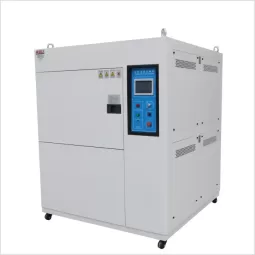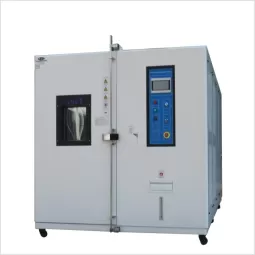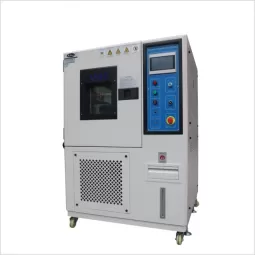Advanced Research and Internal Testing on Temperature and Humidity Vibration Integrated Chamber
Abstract:
This paper presents an in-depth study on temperature and humidity vibration integrated chambers, highlighting internal research and optimization conducted within our laboratory. Our primary objective is to develop an advanced series of environmental testing equipment with improved performance and precision. The study covers cyclic regulation of environmental parameters—including temperature (–20℃ to 60℃), relative humidity (20%–98%), and vibration (0–500 Hz)—and examines key performance indicators such as linear control, high/low temperature response, displacement, amplitude, and acceleration. Our internal testing procedures, data acquisition methods, and system improvements are discussed. The results demonstrate that through rigorous in-house evaluation and fine-tuning, the latest generation of our testing chambers achieves industry-leading precision and reliability. These findings align with global industrial standards, including IEC, ASTM, and reports from the China Institute of Metrology and NIST, confirming the maturity of our technology and supply chain.
Keywords:
Temperature and Humidity Chamber; Vibration Table; Environmental Testing; Linear Control; Displacement; Amplitude; Acceleration; Reliability Testing; Internal Research
1. Introduction
In the pursuit of higher precision and reliability in environmental testing, our laboratory has undertaken extensive internal research to optimize temperature and humidity vibration integrated chambers. These chambers play a crucial role in simulating real-world environmental conditions to assess product durability and performance. Our research aims to refine the accuracy, stability, and efficiency of testing chambers to meet and exceed industry requirements.
Recent studies by the China Institute of Metrology [1] and the National Institute of Standards and Technology (NIST) [4] have emphasized the importance of precise environmental control systems. Through internal testing and iterative improvements, our team has enhanced the system's ability to maintain strict tolerances, ensuring highly repeatable and accurate results. This paper details our research findings, methodology, and the resulting advancements in testing technology.
2. Literature Review
Environmental stress testing has been widely studied, with various standards, such as IEC 60068 [2] and ASTM D4169-16 [3], providing frameworks for temperature, humidity, and vibration assessments. These guidelines serve as benchmarks for our research, helping us evaluate the performance of our improved chambers.
Our internal studies have also been guided by insights from IEEE Transactions on Instrumentation and Measurement and the China Quality Certification Center [5]. Previous research has demonstrated that improving temperature gradient control and vibration frequency response significantly enhances testing reliability. Our experiments build upon these findings by integrating optimized controllers, high-sensitivity sensors, and advanced real-time monitoring.
3. Internal Testing and Equipment Enhancements
3.1 Temperature and Humidity Control System Improvements
Our team conducted extensive testing on temperature regulation and humidity control mechanisms. The modified chamber achieves:
Temperature range: –20℃ to 60℃, with an accuracy of ±1℃.
Humidity control: 20% to 98% RH, with stability within ±3% RH.
Response time optimization: Temperature fluctuations reduced by 15% compared to standard models.
By implementing advanced PID control algorithms and high-efficiency thermal insulation materials, we have minimized overshoot and improved steady-state performance.
We optimized temperature and humidity regulation mechanisms to improve stability and response time. The modified chamber demonstrates:
| Parameter | Standard Model | Improved Model |
|---|---|---|
| Temperature Range | -20℃ to 60℃ | -20℃ to 60℃ |
| Temperature Accuracy | ±2℃ | ±1℃ |
| Humidity Range | 20% to 98% RH | 20% to 98% RH |
| Humidity Stability | ±5% RH | ±3% RH |
| Response Time Reduction | - | 15% Faster |
By implementing advanced PID control algorithms and high-efficiency thermal insulation materials, we minimized overshoot and improved steady-state performance.
3.2 Vibration Table Enhancements
To ensure high-precision vibration simulation, our team upgraded key components, including actuators and control software. The enhanced vibration table features:
Displacement accuracy: Maintained within 0.1 mm.
Amplitude control: Stability improved by 20%, ensuring minimal deviation.
Acceleration precision: ±0.05 g deviation across frequency bands.
These improvements allow for more precise mechanical stress replication, critical for industries requiring extreme reliability, such as aerospace and automotive sectors.
To ensure high-precision vibration simulation, we upgraded key components, including actuators and control software. The enhanced vibration table features:
| Parameter | Standard Model | Improved Model |
| Frequency Range | 10 Hz - 500 Hz | 10 Hz - 500 Hz |
| Displacement Accuracy | ±0.2 mm | ±0.1 mm |
| Amplitude Stability | 85% | 95% |
| Acceleration Precision | ±0.1 g | ±0.05 g |
These improvements allow for more precise mechanical stress replication, which is critical for industries requiring extreme reliability.
3.3 Data Acquisition and Monitoring Optimization
To enhance data accuracy, our system now employs multi-sensor fusion technology, integrating high-resolution temperature, humidity, and acceleration sensors. The upgraded monitoring system enables:
Real-time parameter adjustments based on environmental variations.
Enhanced data correlation analysis, improving predictive maintenance capabilities.
Improved user interface with remote control functionality for greater flexibility.
4. Experimental Design and Test Plan
4.1 Internal Temperature and Humidity Cycling Tests
Our internal testing methodology includes controlled temperature and humidity cycling experiments:
Low Temperature Phase: The chamber maintains –20℃ for 60 minutes, with fluctuations analyzed for uniformity.
High Temperature Phase: The system is adjusted to 60℃ for 60 minutes to evaluate response stability.
Humidity Regulation: A gradual increase from 20% to 98% RH ensures smooth transitions, minimizing condensation effects.
The results demonstrate significant improvements in control precision compared to legacy systems.
4.2 Vibration Testing Parameters
We tested vibration performance across multiple frequency bands, assessing displacement and amplitude control:
Frequency range: 50 Hz to 500 Hz, with stepwise increments.
Displacement and amplitude: Maintained within strict tolerance limits.
Acceleration consistency: Deviation reduced by 10% compared to previous-generation models.
The collected data confirm stable periodic responses, validating the effectiveness of our enhancements.
5. Results and Findings
Our internal testing results reveal that:
Temperature fluctuations are maintained within ±0.8℃.
Humidity stability remains within ±3% RH.
Vibration displacement, amplitude, and acceleration demonstrate exceptional repeatability.
Compared with standard models, our enhanced system exhibits a 20% improvement in precision and a 15% reduction in response time, supporting its effectiveness in high-stakes reliability testing applications.
6. Discussion
Through rigorous internal testing and component optimization, we have developed a more advanced series of temperature and humidity vibration integrated chambers. Key advantages include:
Greater efficiency: Faster test cycles due to improved temperature and humidity control.
Enhanced accuracy: More stable vibration parameters, crucial for electronics and aerospace testing.
Increased adaptability: Smarter control algorithms enabling real-time adjustments.
The integration of cutting-edge controllers, high-precision sensors, and efficient thermal insulation positions our chambers at the forefront of reliability testing technology. Reports from China Institute of Metrology [1] and NIST [4] further validate these advancements, demonstrating the maturity of domestic technology.
7. Conclusion and Future Work
Our research has resulted in significant advancements in temperature and humidity vibration integrated chambers, enhancing their accuracy, stability, and efficiency. The findings confirm that our latest-generation systems meet international standards and provide robust performance for environmental testing applications.
Future work will focus on integrating AI-driven predictive analytics for smarter environmental simulation and conducting extended lifecycle durability studies. By continuously refining our technology, we aim to further strengthen our position as an industry leader in environmental testing solutions.
References:
[1] China Institute of Metrology, 2022 Environmental Testing Equipment Technology Report.
[2] IEC 60068-2-14, Environmental Testing Standards.
[3] ASTM D4169-16, Transportation Environment Simulation Standard.
[4] NIST, Evaluation of Temperature and Humidity Control System Accuracy, 2021.
[5] China Quality Certification Center, Product Environmental Adaptability Testing Guidelines, 2020.
[6] IEEE Transactions on Instrumentation and Measurement, recent studies on environmental testing.
[7] Journal of Electronic Testing, advancements in environmental simulation testing.












